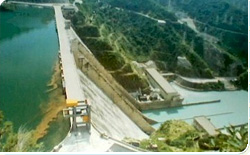 Bhakra Nangal Dam is situated in the city "Bhakra" and its Asia's biggest dam. And is built on the "Sutlej River". It is 225.55 m (740 ft) high above sea- level. The length of the dam (the road above it) is 518.25, and 304.84 m broad. Its huge reservoir known as the "Gobindh Sarovar", stores up to 9621 million cu m, of water enough to drain the whole of the Chandigarh, parts of Haryana, Punjab and Delhi, there were several problems while clearing the area of the village.
Bhakra Nangal Dam is situated in the city "Bhakra" and its Asia's biggest dam. And is built on the "Sutlej River". It is 225.55 m (740 ft) high above sea- level. The length of the dam (the road above it) is 518.25, and 304.84 m broad. Its huge reservoir known as the "Gobindh Sarovar", stores up to 9621 million cu m, of water enough to drain the whole of the Chandigarh, parts of Haryana, Punjab and Delhi, there were several problems while clearing the area of the village.
It also has 4 flood gates which are fully functional during the period of floods and also has 2 power- stations situated on the either sides of the dam, which receives water through huge pipes which are directly connected from the dam's reservoir to each power- plant.
Each of the power plants comprise of 5 generators, and a power station. The total electricity produced in both of the generators is 1325 MW. A generator is actually a reverse of a motor; it has 3 metal plates fixed to an axle coiled with wire, inside a case of 2 magnets (or vice versa) the fast flowing water hits the blades fixed to the axle and is left into the river. This causes the blades to move and, results in the spinning of the wire around the magnets, which causes the formation of electricity. There are further more 2 electrodes randomly fixed around the axles, further connected to 2 separate wires.
This causes the potential of the water to be converted into electrical energy. It also is used for breeding fishes, and also controls the flow of water through small tubes in its structure. There is also a net to separate out the floating impurities to block the tubes. Thus, to sum up a dam is a multipurpose project.
